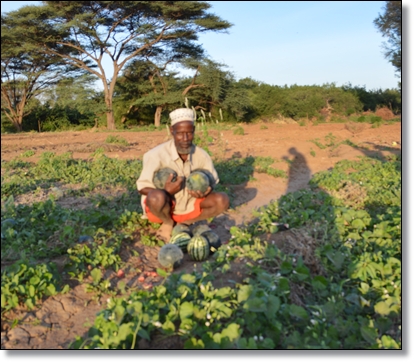Food Security: Oasis of Hope in Isiolo County

 |
| Hassan Halaki in his farm Photo: Mary Mwendwa |
The dusty and windy and hot atmosphere welcomes one to a dry region that has not had rain for the last two years. The small round houses made of reeds (manyatta) are some of the sceneries in the villages. Green grass is rarely seen in most parts, except around the river shores. Only dry shrubs and dry land is visible.
Cows, goats and camels are every villager’s pride. Anyone without these is believed to be the poorest in the community. An individual can own upto 500 goats and several cows and camels. Sadly, when drought strikes, almost all are wiped away due to lack of pastures.
Women dressed in long flowered dresses, buibui (long coloured robes worn by muslim women) headscarfs and men clad in kanzus (long coloured garment with long sleeves mostly worn by men) are common here. Isiolo town is cosmopolitan with a huge military activity. The town borders Meru, and Nanyuki and towns.
The larger Isiolo county is classified among Arid and Semi-Arid Lands (ASAL) in Kenya and from the general look of things, one cannot expect to see some fresh harvest from the farms. I was however proved wrong when I took a tour around the county to understand how people here are coping with the harsh and changing weather patterns.
Ali Galgalo, a livestock keeper and farmer in Merti, over two hundred kilometers from Isiolo town, narrates how relief food made them turn into beggars some time back.
“We relied on relief food when drought came staring in our eyes, but resolved that this was not a long term solution, as relief food is not sustainable and breeds dependency. We want to have local solutions, work and reap our own benefit,” he says.
We have not seen relief food for the last six months, no one knows what has happened , but we are ok, we are feeding from our own farms.”
Galgalo affirms how he has been able to educate and take care of his ten children. He poses a question to me in a bitter tone,
“Imagine me depending on relief food to feed my family of ten kids. How long can that last?”
Similar sentiments are echoed by several farmers that I meet in their farms. All want training on best farming practices as well as programs that avail water for farming. Not relief food.
The only source of water in this region is Ewaso Nyiro river, the third longest river in Kenya which originates from Mt.Kenya and drains its waters into the Lorian swamp.
Amina Boku from Manyatta Sakuyu village in Merti , a mother of eight in her mid-thirties tells me how her life has been transformed after she ventured into farming. She pumps water from the river through a small generator to her farm which is close to the river.
“We had one of the worst droughts in 2011. People lost most of their livestock. Others ran mad. Some committed suicide and others are still living in shock and depression. I lost all my ten cows which were my source of livelihood,” she sadly narrates.
Amina recalls how the whole village was in despair after that drought.Development based organizations came to their rescue by training them on how they could use Ewaso Nyiro waters in a more sustainable way.
“We were trained on which types of crops can do well in this region and how to carry out irrigation,” adds Fatuma Goalicha, another farmer.
The shores of Ewaso Nyiro river are dotted in green with different types of crops: Katumani maize – which matures after three months, water melon, cowpeas, kales, onions and tomatoes, among other crops are grown here.
According to Rashid Guyo, chairperson, of Ewaso River Users Empowerment Platform in Merti, they have been involved in educating communities living down and upstream the Ewaso river about the importance of using the water sustainably.
“The recurring droughts have made us venture into other ways of livelihoods. The community here largely reared livestock but they are now practicing crop farming. Their economic situation has improved drastically,” he says.
He further adds that farmers in Merti Supply vegetables and maize to Isiolo town which is far away. They are able to get money and save and this helps them during the drought seasons. They have plans to partner with other counties that benefit from the Ewaso river to conserve the river. They now call upon the government and other development partners to bring extension services closer.
As I am leaving, I pass at the Gotu bridge. This bridge separates Isiolo South and Isiolo North. A beehive of activities is going on here. A bridge is under construction, women are washing clothes on the shores of Ewaso Nyiro river, hundreds of livestock are drinking to their fill and people busy chatting in low tones.
Not very many vehicles pass here. A crack is visible at the bridge and it’s a clear indicator that it’s a killer bridge. On the right side of the bridge is a huge tunnel with jerry cans floating. Sounds of water falls are part of the ambience here.
I seek to understand why the jerricans are floating on water in the tunnel.
"This is a killer bridge,” I am by Boku Godana, a boy in his mid-twenties. “People die here every now and then. Recently, one lorry that was carrying students to school was washed away killing over thirty people on board. Those jerrycans floating belong to people who have perished in these crocodile and hippo infested waters,” he sadly adds.
By Mary Mwendwa
Freelance Journalist.
